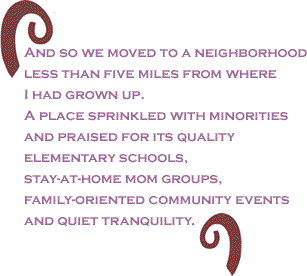
|
|||||||||||||||||||||
|
The current issue is always free to everyone If
you need the access available to a |
 |
 |
| Less
than a month ago, my husband, daughter and I moved from one side
of town to another. We left the environs of what was once perceived
and touted as an area that was welcomingly diverse in terms of
race, economics, religion and social strata until about five years
ago. It was – and is today – filled with apartments,
condos and single family homes at various price points, ranging
from the affordable high five figures to a newly constructed and
luxurious $300,000-plus.
In recent years, as the population of the area
has yellowed, browned and blackened, as foreign accents and languages
have become more resonant, as signage for businesses are filled
with tildes and accent marks, as salsa, merengue and reggaeton
music have replaced R&B and rock tunes blasting from cars,
as headlines in the media seemed to collectively conspire to blacklist
the neighborhood, as fear-flight made homeowners settle for foreclosure
or abandon their homes before being sold … we were pressured
by family and friends to consider a move.
I was more willing than my husband to attempt
to wait things out before listing our home for sale. I had grown
up in a predominantly white neighborhood and since striking out
on my own had purposely chosen to live in more diversified areas.
But my husband had had enough. Too much loud music blasting on
Sunday mornings and an El Salvadorian three-year-old riding his
tricycle in his underwear in the street were enough for him, and
a police stake-out across the street at an alleged drug dealer’s
house was the last straw for us both. As my family joked about “moving on up”
like The Jeffersons and my husband basked in the sleepy suburban
scenery, the euphoria was quickly clipped on the first night in
our new home. We awoke the next morning to a neighbor knocking
on our door and warning us of a series of approximately 50 car
break-ins the night before. Outside flurries of shattered glass
from my husband’s truck lined our driveway.
Then a couple of weeks later, we
got some mail from the Homeowners Association. We expected it
to be the bill for the first month’s monthly dues, only
to find a report of vandalism at the community pool. Pool furniture
had been destroyed, the pool itself had been damaged, and presumably
stolen items were scattered poolside. Homeowners were forewarned
that projected repair costs could range from $8,000-$10,000. BC Columnist K. Danielle Edwards is a Nashville-based writer, poet and communications professional. She is the author of Stacey Jones: Memoirs of Girl and Woman, Body & Spirit, Life and Death (2005) and is the founder and creative director of The Pen: An Exercise in the Cathartic Potential of the Creative Act, a nonprofit creative writing project designed for incarcerated and disadvantaged populations. Click here to contact Ms. Edwards. |
| July
26, 2007 Issue 239 |
|
| Printer Friendly Version in resizeable plain text format format |
 |
 |
 |
| |
| |

































